Mapping the TOGAF ADM to the Zachman Framework
Introduction The Zachman Framework Mapping
TOGAF to the Zachman Framework
A number of architecture frameworks exist, each of which has its particular advantages
and disadvantages, and relevance, for enterprise architecture. Several are discussed in Other Architectures and Frameworks.
However, there is no accepted industry standard method for developing an
enterprise architecture. The Open Group's goal with TOGAF is to work towards making the
TOGAF Architecture Development Method just such an industry standard method, which can be
used for developing the products associated with any recognized enterprise framework that
the architect feels is appropriate for a particular architecture. The Open Group's vision
for TOGAF is as a vehicle and repository for practical, experience-based information on
how to go about the process of enterprise architecture, providing a generic method with
which specific sets of deliverables, specific reference models, and other relevant
architectural assets, can be integrated.
To illustrate the concept, this section provides a mapping of the various Phases of the
TOGAF ADM to the cells of the well known Zachman Framework.
The Zachman Framework for Enterprise Architecture, sometimes simply referred to as
"The Zachman Framework", has become a de facto standard for classifying the
artifacts developed in enterprise architecture. It is a logical structure for classifying
and organizing the design artifacts of an enterprise that are significant to its
management. It draws on a classification scheme found in the more mature disciplines of
Architecture/Construction and Engineering/Manufacturing, used for classifying and
organizing the design artefacts relating to complex physical products such as a building
or an aircraft. Zachman adopts this classification scheme to the design and construction
of information systems.
The Zachman Framework comprises a 6x6 matrix.
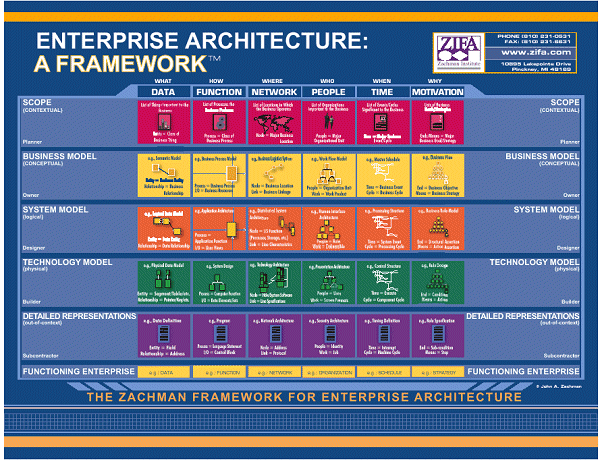
The columns represent various aspects of the enterprise that can be described, or
modeled; and the rows represent various viewpoints from which the aspects can be
described. Thus each cell formed by the intersection of a column and a row represents an
aspect of the enterprise modeled from a particular viewpoint. The architect selects and
models the cells that are appropriate to the immediate purpose, with the ultimate
objective of modeling all the cells.
The six viewpoints are:
1. The Scope (Contextual) Viewpoint - aimed at the Planner
2. The Business Model (Conceptual) Viewpoint - aimed at the Owner
3. The System (Logical) Viewpoint - aimed at the Designer
4. The Technology (Physical) Viewpoint - aimed at the Builder
5. The Detailed Representations (Out-of-Context) Viewpoint - aimed at the Subcontractor
6. The Functioning Enterprise Viewpoint
The six aspects - and the interrogatives to which they correspond - are:
1. The Data aspect - What?
2. The Function aspect - How?
3. The Network aspect - Where?
4. The People aspect - Who?
5. The Time aspect - When?
6. The Motivation aspect - Why?
Although the Zachman Framework applies to enterprises, the Framework itself is generic.
It is a comprehensive, logical structure for the descriptive representations (i.e. models,
or design artefacts) of any complex object, and it does not prescribe or describe any
particular method, representation technique, or automated tool.
The strength of the framework is that it provides a way of thinking about an enterprise
in an organized way, so that it can be described and analyzed. It also enables the
individuals involved in producing enterprise information systems to focus on selected
aspects of the system without losing sight of the overall enterprise context. In designing
and building complex systems, such as enterprise systems, there are simply too many
details and relationships to consider simultaneously. At the same time, isolating single
variables and making design decisions out of context results in sub-optimization, with all
the attendant costs and risks. The challenge is the same whether the system is physical,
like an aircraft, or conceptual, like an enterprise system. How do you design and build
it, piece by piece, and step by step, such that it achieves its purpose without losing its
value and raising its cost by optimizing the pieces and sub-optimizing the overall?
Mapping TOGAF to the Zachman Framework
The scope of the four architecture domains of TOGAF aligns very well with the first
four rows of the Zachman Framework, as shown in the following mapping of these domains:
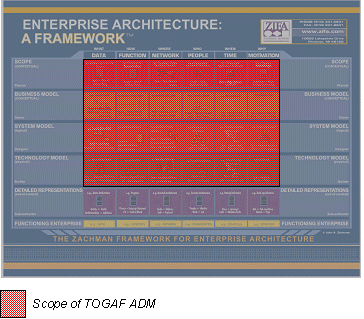
Several domains overlap in the above diagram: the earliest domain to address a cell has
precedence in the coloring scheme.
The mappings of the individual phases of the ADM are shown in detail below.
It should be noted that, in addition to the mappings to
specific cells given below, the Detailed Representations and Functioning Enterprise
viewpoints (the lowest two rows) of the Zachman Model are also addressed and represented
in TOGAF, through the Architecture Governance Framework,
and through ADM deliverables such as the various Architecture
Contracts. These ensure the validity and viability of the delivered solutions to meet
the business needs.
Preliminary Phase: Framework and Principles
The outputs of this phase are:
- Framework Definition
- ZF: Business/Function (model of the architecture development process) [R2,C2]
- Architecture Principles
- ZF: Scope/Data, Scope/Function, Scope/Network, Scope/People, Scope/Time,
Scope/Motivation [R1,C1; R1,C2; R1,C3; R1,C4; R1,C5; R1,C6]
- Restatement of, or reference to, Business Principles, Business Goals and Business
Drivers
- ZF: Composite of: Scope/Motivation, Business/Motivation [R1,C6; R2,C6]
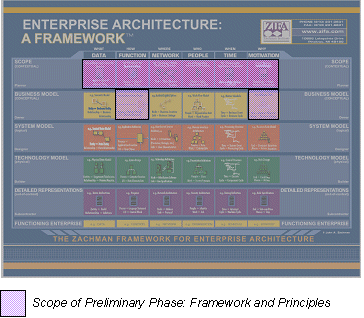
Phase A: Architecture Vision
The outputs of this phase are:
- Approved Statement of Architecture Work / Project Definition, including in particular:
- Scope and constraints
- ZF: Scope/Data, Scope/Function, Scope/Network, Scope/People, Scope/Time [R1,C1;
R1,C2; R1,C3; R1,C4; R1,C5; R1,C6]
- Note: The Scope/motivation cell is presumed to be addressed by strategic business
planning activites outside the scope of the Architecture Vision
- Plan for the architecture work
- Refined statements of Business Principles, Business Goals and Strategic Drivers
- ZF: Scope/Data, Scope/Motivation [R1,C1; R1,C6]
- Architecture Principles (if not previously existing)
- ZF: Scope/Data, Scope/Function, Scope/Network, Scope/People, Scope/Time,
Scope/Motivation [R1,C1; R1,C2; R1,C3; R1,C4; R1,C5; R1,C6]
- Architecture Vision / Business Scenario, including:
- Business Baseline Version 1
- ZF: Business/Data, Business/Function,
Business/Network, Business/People, Business/Time,
Business/Motivation [R2,C2; R2,C2; R2,C3;
R2,C4; R2,C5; R2,C6]
- Technical Baseline Version 1
- ZF: System/Data, System/Function,
System/Network, System/People, System/Time,
System/Motivation [R3,C2; R3,C2; R3,C3;
R3,C4; R3,C5; R3,C6]
- Business Architecture Version 1
- ZF: Business/Data, Business/Function,
Business/Network, Business/People, Business/Time,
Business/Motivation [R2,C2; R2,C2; R2,C3;
R2,C4; R2,C5; R2,C6]
- Technical Architecture Version 1
- ZF: System/Data, System/Function,
System/Network, System/People, System/Time,
System/Motivation [R3,C2; R3,C2; R3,C3;
R3,C4; R3,C5; R3,C6]
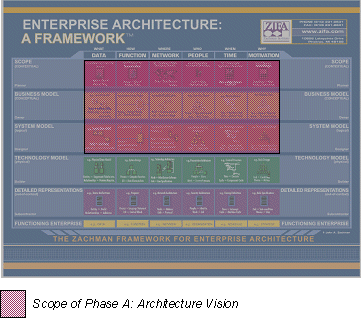
Phase B: Business Architecture
The outputs of this phase are:
- Statement of Architecture Work (updated if necessary)
- Validated business principles, business goals, and strategic drivers
- ZF: Scope/Data, Scope/Function, Scope/Network, Scope/People, Scope/Time [R1,C1;
R1,C2; R1,C3; R1,C4; R1,C5; R1,C6]
- Target Business Architecture - Version 2 (detailed)
- Organization structure, identifying business locations and relating them to
organizational units.
- ZF: Scope/Network, Scope/People, Business/Network, Business/People
- [R1,C3; R1,C4; R2,C3; R2,C4]
- Business goals and objectives, for each organizational unit.
- ZF: Scope/Network, Scope/Time, Business/Network, Business/Time, Business/Motivation [R1,C3;
R1,C5; R2,C3; R2,C5; R2,C6]
- Note: The Scope/motivation cell is presumed to be addressed by strategic business
planning activites outside the scope of the Business Architecture
- Business functions. a detailed, recursive step involving successive
decomposition of major functional areas into sub-functions.
- ZF: Scope/Function, Business/Function [R1,C2; R2,C2]
- Business Services - the services that each enterprise unit provides to its
customers, both internally and externally.
- ZF: Business/Function, System/Function [R2,C2; R3,C2]
- Business processes, including measures and deliverables
- ZF: Business/Function, Business/Time [R2,C2; R2,C5]
- Business roles, including development and modification of skills requirements.
- ZF: Scope/People, Business/People [R1,C4; R2,C4]
- Correlation of organization and functions. Relate business functions to
organizational units in the form of a matrix report.
- ZF: Scope/Function, Scope/Network, Scope/People, Business/Function, Business/Network,
Business/People [R1,C2; R1,C3; R1,C4; R2,C2; R2,C3; R2,C4]
- Business Baseline - Version 2 (detailed) - if appropriate
- Views corresponding to the selected viewpoints addressing key stakeholder concerns
- Gap analysis results
- Technical requirements (drivers for the Technical Architecture work): identifying,
categorising and prioritising the implications for work in the remaining architecture
domains; for example, by a dependency/ priority matrix. (For example, guiding trade-off
between speed of transaction processing and security.) List the specific models that are
expected to be produced (for example, expressed as primitives of the Zachman Framework).
- ZF: System/Motivation [R3,C6]
- Business Architecture Report
- Updated business requirements
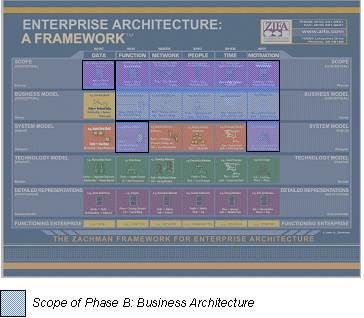
Note:
Phase C: Informations System Architectures: Data Architecture
The outputs of this part of Phase C are:
- Statement of Architecture Work (updated if necessary)
- Data Baseline Description - if appropriate
- Validated Principles, or new Data Principles (if generated here)
- ZF: Scope/Data, Scope/Network, Scope/People, Scope/Time [R1,C3; R1,C4; R1,C5]
- Target Data Architecture
- Conceptual data model
- ZF: Business/Data [R2,C1]
- Logical data model
- Data Management Process models
- ZF: System/Function, System/People [R3,C2; R3,C3]
- Data entity / business function matrix
- ZF: Composite of Business/People, System/Data, System/Function, [R2,C4; R3,C1;
R3,C2]
- Data interoperability requirements
- ZF: Composite of System/Data, System/Function, System/Network, System/People [R3,C1;
R3,C2; R3,C3; R3,C4]
- Viewpoints addressing key stakeholder concerns.
- Views corresponding to the selected viewpoints; e.g.:
- Data dissemination view
- ZF: Composite of System/Data, System/Function, System/Network, System/People [R3,C1;
R3,C2; R3,C3; R3,C4]
- Data lifecycle view
- ZF: Composite of System/Data, System/Function, System/Time
- Data security view
- ZF: Composite of System/Function, System/Data, System/Network, System/People,
System/Time
- Data model management view
- ZF: Composite of Business/Data, System/Data, Business/Time, System/Time
- Gap analysis results
- Relevant technical requirements that will apply to this evolution of the architecture
development cycle
- Data Architecture Report, summarizing what was done and the key findings
- Impact Analysis
- Updated business requirements (if appropriate)

Phase C: Informations System Architectures: Applications
Architecture
The outputs of this part of Phase C are:
- Statement of Architecture Work (updated if necessary)
- Applications Baseline Description - if appropriate
- Validated Applications Principles, or new Applications Principles (if generated here)
- ZF: Scope/Function, Scope/Network, Scope/People, Scope/Time
- Target Applications Architecture
- Process Systems Model
- Sytems / Place Model
- People / Systems Model
- Systems / Time Model
- Applications interoperability requirements
- ZF: Composite of System/Data, System/Function, System/Network, System/People,
System/Time, System/Motivation
- Viewpoints addressing key stakeholder concerns.
- Views corresponding to the selected viewpoints; e.g.:
- Common Applications services view
- ZF: Composite of System/Data, System/Function, System/Network, System/People,
System/Time
- Applications Interoperability view
- ZF: Composite of System/Data, System/Function, System/Network, System/Time
- Applications / Information View
- ZF: Composite of System/Data, System/Function, System/Network, System/Time
- Applications / User locations View
- ZF: Composite of System/Network, System/People
- Gap analysis results
- Areas where the Business Architecture may need to change to cater for changes in the
Applications Architecture
- ZF: Composite of Business/Data, Business/Function, Business/Network, Business/People,
Business/Time
- Identify any areas where the Data Architecture (if generated at this point) may need to
change to cater for changes in the Applications Architecture.
- ZF: Composite of Business/Data, Business/People, Business/Time
- Identify any constraints on the Technology Architecture about to be designed.
- Applications Architecture Report, summarizing what was done and the key findings
- Impact Analysis
- Updated business requirements (if appropriate)
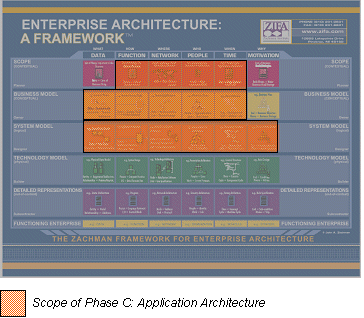
Phase D: Technology Architecture
The outputs of Phase D are given below, first by relevant individual Step, and then as
a composite for the whole phase.
Step 1. Create a baseline description in the TOGAF format
The outputs of this step are:
- Technology Architecture principles (if not existing)
- ZF: Scope/Data, Scope/Function, Scope/Network, Scope/People, Scope/Time,
Scope/Motivation
- Technology Architecture Version 0.1:
- Technology Architecture - Constraints
- Technology Architecture - Architecture Principles
- Technology Architecture - Requirements Traceability - key questions list
- Technology Architecture - Requirements Traceability - criteria for selection of service
portfolio
- Technology Architecture Model - Version 0.1
- ZF: Technology/Function, Technology/Network
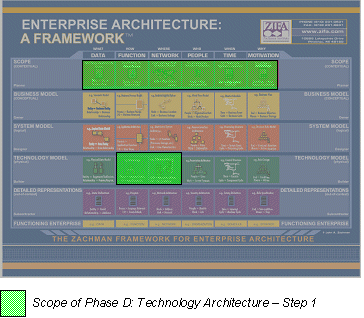
Step 2. Consider different architecture reference models, viewpoints, and tools
The outputs of this step are:
- Technology Architecture Version 0.2
- Technology Architecture - Architecture Viewpoints
- Networked Computing/Hardware View
- ZF: System/Network, Technology/Network
- Communications View
- ZF: Composite of: System/Network, System/People, Technology/Network, Technology/People
- Processing View
- ZF: System/Data, System/Function, System/Network, System/People, System/Time,
Technology/Data, Technology/Function, Technology/Network, Technology/People,
Technology/Time
- Cost View
- ZF: Technology / Motivation
- Standards View
- ZF: Technology / Motivation
- Technology Architecture - Constraints
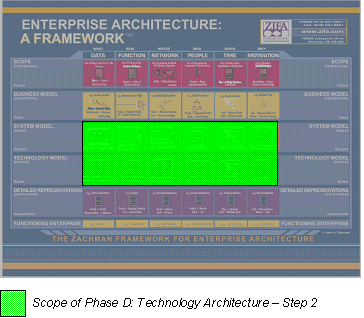
Step 3. Create an architectural model of building blocks
The outputs of this step are:
- Technology Architecture Version 0.3
- Technology Architecture Model
- Networked Computing/ Hardware View
- ZF: Technology / Network, System / Network
- Communications View
- ZF: Composite of: Technology / Network, Technology / People, System / Network, System /
People
- Processing View
- ZF: Technology / Network, Technology / Time, Technology / People, Technology / Data,
Technology/Function, System / Network, System / Time, System / People, System / Data,
System/Function
- Cost View
- ZF: Technology / Motivation
- Standards View
- ZF: Technology / Motivation
- Technology Architecture - change requests and/or extensions or amendments to be
incorporated in an organization-specific architecture continuum.
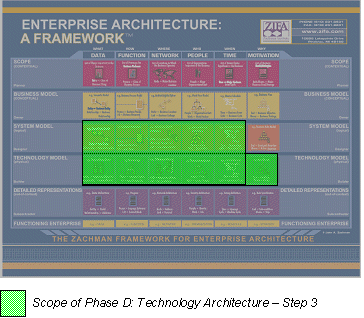
4. Select the services portfolio required per building block
The outputs of this step are:
- Technology Architecture Version 0.4
- Technology Architecture - target services (a description of the service portfolios
required also known as an Organization Specific Framework)
- ZF: Technology / Network, Technology / Time, Technology / People, Technology / Data,
Technology/Function, Technology/Motivation
- Technology Architecture - change requests and/or extensions or amendments to be
incorporated in an organization-specific architecture continuum
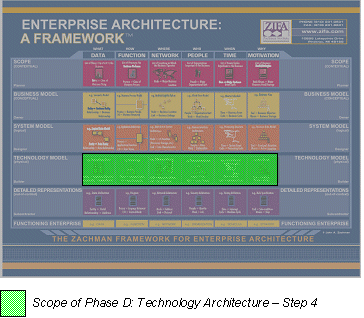
Step 8. Conduct a gap analysis
The outputs of this step are:
- Technology Architecture Version 1
- Technology Architecture - gap report
- ZF: Composite of Technology/Data, Technology/ Function, Technology/Network,
Technology/People, Technology/Time, Technology/Motivation
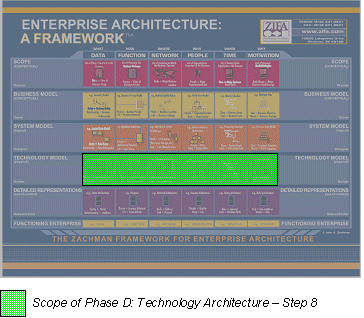
Composite Mapping for phase D
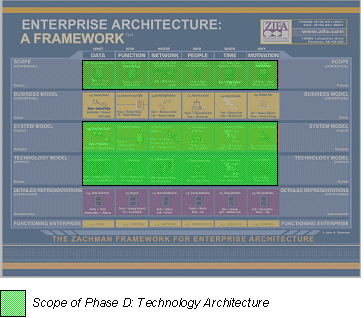
For more detailed information on the Zachman Framework, refer to any of John Zachman's
publications, or the Zachman Institute for Framework
Advancement (ZIFA).
Copyright � The Open Group, 2002













